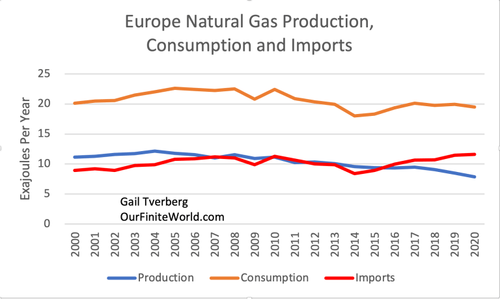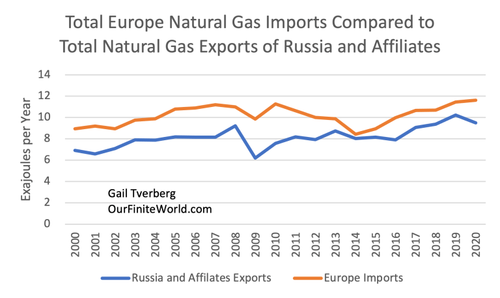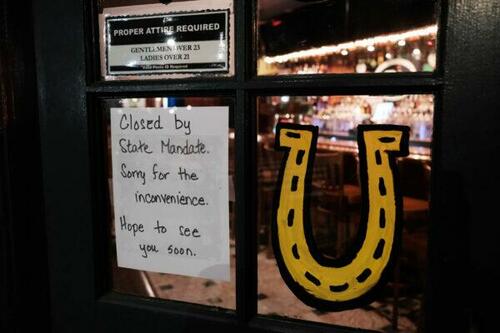How cool would it be if we all had a portable fusion reactor in our home, jetson's like and unlimited energy available? Although nobody will entertain such fantasies nowadays, talking about renewables in similar glowing praise is not only still possible but encouraged, so much so that voicing doubts about the potential of renewables is frowned upon. With the risk of sounding like an heretic after mass, the limits of green energy are nevertheless getting clearer, even while the real costs are obfuscated and hidden behind the curtain of "clean" which most are not.
The reality as this article makes clear with detailed numbers, is that the future of our current society cannot be "green", and if it is, it will be a rather dark future, sliced with intermittent brown-outs and horrendously expensive electricity. (The two most likely options when you read between the lines.) Of all subjects, energy is the one which does least tolerate "ideology" and short-cuts. Physics guaranties that the road to really green energy will be a long one which will require a complete re-engineering of our society, the way we live and the way we think. That social crisis will therefore arrive long before we have invested the 30 to 50 years of effort necessary for green technological development. We most certainly could have invested the hundreds of billions of dollars used for nuclear weapons over the last 70 years into energy but that option never was on the table. Now, we are facing our growing needs for energy with dwindling fossil resources, while our population is still exploding and all these not-so-clean green energies remain marginal...
Authored by Gail Tverberg via Our Finite World,
We
have been told that intermittent electricity from wind and solar,
perhaps along with hydroelectric generation (hydro), can be the basis of
a green economy. Things are increasingly not working out as planned,
however. Natural gas or coal used for balancing the intermittent output
of renewables is increasingly high-priced or not available. It is
becoming clear that modelers who encouraged the view that a smooth
transition to wind, solar, and hydro is possible have missed some
important points.
Let’s look at some of the issues:
[1]
It is becoming clear that intermittent wind and solar cannot be counted
on to provide adequate electricity supply when the electrical
distribution system needs them.
Early modelers did not
expect that the variability of wind and solar would be a huge problem.
They seemed to believe that, with the use of enough intermittent
renewables, their variability would cancel out. Alternatively, long
transmission lines would allow enough transfer of electricity between
locations to largely offset variability.
In practice, variability
is still a major problem. For example, in the third quarter of 2021,
weak winds were a significant contributor to Europe’s power crunch.
Europe’s largest wind producers (Britain, Germany and France) produced only
14% of installed capacity during this period, compared with an average
of 20% to 26% in previous years. No one had planned for this kind of
three-month shortfall.
In 2021, China experienced dry, windless weather so
that both its generation from wind and hydro were low. The country
found it needed to use rolling blackouts to deal with the situation.
This led to traffic lights failing and many families needing to eat
candle-lit dinners.
In Europe, with low electricity supply, Kosovo has needed to use rolling blackouts. There is real concern that the need for rolling blackouts will spread to other parts of Europe,
as well, either later this winter, or in a future winter. Winters are
of special concern because, then, solar energy is low while heating
needs are high.
[2] Adequate storage for electricity is
not feasible in any reasonable timeframe. This means that if cold
countries are not to “freeze in the dark” during winter, fossil fuel
backup is likely to be needed for many years in the future.
One workaround for electricity variability is storage. A recent Reuters’ article is titled, Weak winds worsened Europe’s power crunch; utilities need better storage.
The article quotes Matthew Jones, lead analyst for EU Power, as saying
that low or zero-emissions backup-capacity is “still more than a decade
away from being available at scale.” Thus, having huge batteries or
hydrogen storage at the scale needed for months of storage is not
something that can reasonably be created now or in the next several
years.
Today, the amount of electricity storage that is available
can be measured in minutes or hours. It is mostly used to buffer
short-term changes, such as the wind temporarily ceasing to blow or the
rapid transition created when the sun sets and citizens are in the midst
of cooking dinner. What is needed is the capacity for multiple months
of electricity storage. Such storage would require an amazingly large
quantity of materials to produce. Needless to say, if such storage were
included, the cost of the overall electrical system would be
substantially higher than we have been led to believe. All major types
of cost analyses (including the levelized cost of energy, energy return
on energy invested, and energy payback period) leave out the need for
storage (both short- and long-term) if balancing with other electricity
production is not available.
If no solution to inadequate
electricity supply can be found, then demand must be reduced by one
means or another. One approach is to close businesses or schools.
Another approach is rolling blackouts. A third approach is to permit
astronomically high electricity prices, squeezing out some buyers of
electricity. A fourth balancing approach is to introduce recession,
perhaps by raising interest rates; recessions cut back on demand for all
non-essential goods and services. Recessions tend to lead to
significant job losses, besides cutting back on electricity demand. None
of these things are attractive options.
[3] After many
years of subsidies and mandates, today’s green electricity is only a
tiny fraction of what is needed to keep our current economy operating.
Early modelers did not consider how difficult it would be to ramp up green electricity.
Compared
to today’s total world energy consumption (electricity and
non-electricity energy, such as oil, combined), wind and solar are truly insignificant.
In 2020, wind accounted for 3% of the world’s total energy consumption
and solar amounted to 1% of total energy, using BP’s generous way of
counting electricity, relative to other types of energy. Thus, the
combination of wind and solar produced 4% of world energy in 2020.
The
International Energy Agency (IEA) uses a less generous approach for
crediting electricity; it only gives credit for the heat energy supplied
by the renewable energy. The IEA does not show wind and solar
separately in its recent reports. Instead, it shows an “Other” category
that includes more than wind and solar. This broader category amounted to 2% of the world’s energy supply in 2018.
Hydro
is another type of green electricity that is sometimes considered
alongside wind and solar. It is quite a bit larger than either wind or
solar; it amounted to 7% of the world’s energy supply in 2020. Taken
together, hydro + wind + solar amounted to 11% of the world’s energy
supply in 2020, using BP’s methodology. This still isn’t much of the
world’s total energy consumption.
Of course, different parts of
the world vary with respect to the share of energy created using wind,
hydro and solar. Figure 1 shows the percentage of total energy generated
by these three renewables combined.

Figure
1. Wind, solar and hydro as a share of total energy consumption for
selected parts of the world, based on BP’s 2021 Statistical Review of
World Energy data. Russia+ is Russia and its affiliates in the
Commonwealth of Independent States (CIS).
As expected, the
world average is about 11%. The European Union is highest at 14%;
Russia+ (that is, Russia and its Affiliates, which is equivalent to the
members of the Commonwealth of Independent States) is lowest at 6.5%.
[4] Even as a percentage of electricity, rather than total energy, renewables still comprised a relatively small share in 2020.
Wind and solar don’t replace “dispatchable”
generation; they provide some temporary electricity supply, but they
tend to make the overall electrical system more difficult to operate
because of the variability introduced. Renewables are available only
part of the time, so other types of electricity suppliers are still
needed when supply temporarily isn’t available. In a sense, all they are
replacing is part of the fuel required to make electricity. The fixed
costs of backup electricity providers are not adequately compensated,
nor are the costs of the added complexity introduced into the system.
If
analysts give wind and solar full credit for replacing electricity, as
BP does, then, on a world basis, wind electricity replaced 6% of total
electricity consumed in 2020. Solar electricity replaced 3% of total
electricity provided, and hydro replaced 16% of world electricity. On a
combined basis, wind and solar provided 9% of world electricity. With
hydro included as well, these renewables amounted to 25% of world
electricity supply in 2020.
The share of electricity supply
provided by wind, solar and hydro varies across the world, as shown in
Figure 2. The European Union is highest at 32%; Japan is lowest at 17%.

Figure
2. Wind, solar and hydro as a share of total electricity supply for
selected parts of the world, based on BP’s 2021 Statistical Review of
World Energy data.
The “All Other” grouping of countries
shown in Figure 2 includes many of the poorer countries. These countries
often use quite a bit of hydro, even though the availability of hydro
tends to fluctuate a great deal, depending on weather conditions. If an
area is subject to wet seasons and dry seasons, there is likely to be
very limited electricity supply during the dry season. In areas with
snow melt, very large supplies are often available in spring, and much
smaller supplies during the rest of the year.
Thus, while hydro is
often thought of as being a reliable source of power, this may or may
not be the case. Like wind and solar, hydro often needs fossil fuel
back-up if industry is to be able to depend upon having electricity
year-around.
[5] Most modelers have not understood that
reserve to production ratios greatly overstate the amount of fossil
fuels and other minerals that the economy will be able to extract.
Most
modelers have not understood how the world economy operates. They have
assumed that as long as we have the technical capability to extract
fossil fuels or other minerals, we will be able to do so. A popular way
of looking at resource availability is as reserve to production ratios.
These ratios represent an estimate of how many years of production
might continue, if extraction is continued at the same rate as in the
most recent year, considering known resources and current technology.

Figure 3. Reserve to production ratios for several minerals, based on data from BP’s 2021 Statistical Review of World Energy.
A
common belief is that these ratios understate how much of each resource
is available, partly because technology keeps improving and partly
because exploration for these minerals may not be complete.
In
fact, this model of future resource availability greatly overstates the
quantity of future resources that can actually be extracted. The problem
is that the world economy tends to run short of many types of resources simultaneously. For example, World Bank Commodities Price Data shows
that prices were high in January 2022 for many materials, including
fossil fuels, fertilizers, aluminum, copper, iron ore, nickel, tin and
zinc. Even though prices have run up very high, this is not an
indication that producers will be able to use these high prices to
extract more of these required materials.
In order to produce more
fossil fuels or more minerals of any kind, preparation must be started
years in advance. New oil wells must be built in suitable locations; new
mines for copper or lithium or rare earth minerals must be built;
workers must be trained for all of these areas. High prices for many
commodities can be a sign of temporarily high demand, or it can be a
sign that something is seriously wrong with the system. There is no way
the system can ramp up needed production in a huge number of areas at
once. Supply lines will break. Recession is likely to set in.
The
problem underlying the recent spike in prices seems to be “diminishing
returns.” Such diminishing returns affect nearly all parts of the
economy simultaneously. For each type of mineral, miners produced the
easiest-t0-extract materials first. They later moved on to deeper oil
wells and minerals from lower grade ores. Pollution gradually grew, so,
it too, needed greater investment. At the same time, world population
has been growing, so the economy has required more food, fresh water and
goods of many kinds; these, too, require the investment of resources of
many kinds.
The problem that eventually hits the economy is that
it cannot maintain economic growth. Too many areas of the economy
require investment, simultaneously, because diminishing returns keeps
ramping up investment needs. This investment is not simply a financial
investment; it is an investment of physical resources (oil, coal, steel,
copper, etc.) and an investment of people’s time.
The way in which the economy would run short of investment materials was simulated in the 1972 book, The Limits to Growth, by
Donella Meadows and others. The book gave the results of a number of
simulations regarding how the world economy would behave in the future.
Virtually all of the simulations indicated that eventually the economy
would reach limits to growth. A major problem was that too large a share
of the output of the economy was needed for reinvestment, leaving too
little for other uses. In the base model, such limits to growth came
about now, in the middle of the first half of the 21st century. The
economy would stop growing and gradually start to collapse.
[6]
The world economy seems already to be reaching limits on the extraction
of coal and natural gas to be used for balancing electricity provided
by intermittent renewables.
Coal and natural gas are
expensive to transport so, if they are exported, they primarily tend to
be exported to countries that are nearby. For this reason, my analysis
groups together exports and imports into large regions where trade is
most likely to take place.
If we analyze natural gas imports by
part of the world, two regions stand out as having the most
out-of-region natural gas imports: Europe and Asia-Pacific. Figure 4
shows that Europe’s out-of region natural gas imports reached peaks in
2007 and 2010, after which they dipped. In recent years, Europe’s
imports have barely surpassed their prior peaks. Asia-Pacific’s
out-of-region imports have shown a far more consistent growth long-term
growth pattern.

Figure
4. Natural gas imports in exajoules per year, based on data from on
data from BP’s 2021 Statistical Review of World Energy.
The
reason why Asia-Pacific’s imports have been growing is to support its
growing manufacturing output. Manufacturing output has increasingly been
shifted to the Asia-Pacific region, partly because this region can
perform this manufacturing cheaply, and partly because rich countries
have wanted to reduce their carbon footprint. Moving heavy industry
abroad reduces a country’s reported CO2 generation, even if the
manufactured items are imported as finished products.
Figure 5
shows that Europe’s own natural gas supply has been falling. This is a
major reason for its import requirements from outside the region.

Figure
5. Europe’s natural gas production, consumption and imports based on
data from BP’s 2021 Statistical Review of World Energy.
Figure
6, below, shows that Asia-Pacific’s total energy consumption per capita
has been growing. The new manufacturing jobs transferred to this region
have raised standards of living for many workers. Europe, on the other
hand, has reduced its local manufacturing. Its people have tended to get
poorer, in terms of energy consumption per capita. Service jobs
necessitated by reduced energy consumption per capita have tended to pay
less well than the manufacturing jobs they have replaced.

Figure
6. Energy consumption per capita for Europe compared to Asia-Pacific,
based on data from BP’s 2021 Statistical Review of World Energy.
Europe
has recently been having conflicts with Russia over natural gas. The
world seems to be reaching a situation where there are not enough
natural gas exports to go around. The Asia-Pacific Region (or at least
the more productive parts of the Asia-Pacific Region) seems to be able
to outbid Europe, when local natural gas supply is inadequate.
Figure
7, below, gives a rough idea of the quantity of exports available from
Russia+ compared to Europe’s import needs. (In this chart, I compare
Europe’s total natural gas imports (including pipeline imports from
North Africa and LNG from North Africa) with the natural gas exports of
Russia+ (to all nations, not just to Europe, including both by pipeline
and as LNG)). On this rough basis, we find that Europe’s natural gas
imports are greater than the total natural gas exports of Russia+.

Figure
7. Total natural gas imports of Europe compared to total natural gas
exports from Russia+, based on data from BP’s 2021 Statistical Review of
World Energy.
Europe is already encountering multiple
natural gas problems. Its supply from North Africa is not as reliable as
in the past. The countries of Russia+ are not delivering as much
natural gas as Europe would like, and spot prices, especially, seem to
be way too high. There are also pipeline disagreements. Bloomberg
reports that Russia will be increasing its exports to
China in future years. Unless Russia finds a way to ramp up its gas
supplies, greater exports to China are likely to leave less natural gas
for Russia to export to Europe in the years ahead.
If we look
around the world to see what other sources of natural gas exports are
available for Europe, we discover that the choices are limited.

Figure
8. Historical natural gas exports based on data from BP’s 2021
Statistical Review of World Energy. Rest of the world includes Africa,
the Middle East and the Americas excluding the United States.
The
United States is presented as a possible choice for increasing natural
gas imports to Europe. One of the catches with growing natural gas
exports from the United States is the fact that historically, the US has
been a natural gas importer; it is not clear how much exports
can rise above the 2022 level. Furthermore, part of US natural gas is
co-produced with oil from shale. Oil from shale is not likely to be growing much
in future years; in fact, it very likely will be declining because of
depleted wells. This may limit the US’s growth in natural gas supplies
available for export.
The Rest of the World category on Figure 8
doesn’t seem to have many possibilities for growth in imports to Europe,
either, because total exports have been drifting downward. (The Rest of
the World includes Africa, the Middle East, and the Americas excluding
the United States.) There are many reports of countries, including Iraq
and Turkey, not being able to buy the natural gas they would like. There
doesn’t seem to be enough natural gas on the market now. There are few
reports of supplies ramping up to replace depleted supplies.
With
respect to coal, the situation in Europe is only a little different.
Figure 9 shows that Europe’s coal supply has been depleting, and imports
have not been able to offset this depletion.

Figure 9. Europe’s coal production, consumption and imports, based on data from BP’s 2021 Statistical Review of World Energy.
If a person looks around the world for places to get more imports for Europe, there aren’t many choices.

Figure 10. Coal production by part of the world, based on data from BP’s 2021 Statistical Review of World Energy.
Figure
10 shows that most coal production is in the Asia-Pacific region. With
China, India and Japan located in the Asia-Pacific Region, and high
transit costs, this coal is unlikely to leave the region. The United
States has been a big coal producer, but its production has declined in
recent years. It still exports a relatively small amount of coal. The
most likely possibility for increased coal imports would be from Russia
and its affiliates. Here, too, Europe is likely to need to outbid China
to purchase this coal. A better relationship with Russia would be
helpful, as well.
Figure 10 shows that world coal production has
been essentially flat since 2011. A country will only export coal that
it doesn’t need itself. Thus, a shortfall in export capability is an
early warning sign of inadequate overall supply. With the economies of
many Asia-Pacific countries still growing rapidly, demand for coal
imports is likely to grow for this region. While modelers may think that
there is close to 150 years’ worth of coal supply available, real-world
experience suggests that coal limits are being reached already.
[7]
Conclusion. Modelers and leaders everywhere have had a basic
misunderstanding of how the economy operates and what limits we are up
against. This misunderstanding has allowed scientists to put together
models that are far from the situation we are actually facing.
The
economy operates as an integrated whole, just as the body of a human
being operates as an integrated whole, rather than a collection of cells
of different types. This is something most modelers don’t understand,
and their techniques are not equipped to deal with.
The economy is
facing many limits simultaneously: too many people, too much pollution,
too few fish in the ocean, more difficult to extract fossil fuels and
many others. The way these limits play out seems to be the way the
models in the 1972 book, The Limits to Growth, suggest: They
play out on a combined basis. The real problem is that diminishing
returns leads to huge investment needs in many areas simultaneously. One
or two of these investment needs could perhaps be handled, but not all
of them, all at once.
The approach of modelers, practically
everywhere, is to break down a problem into small parts, and assume that
each part of the problem can be solved independently. Thus, those
concerned about “Peak Oil” have been concerned about running out of oil.
Finding substitutes seemed to be important. Those concerned about
climate change were convinced that huge amounts of fossil fuels remain
to be extracted, even more than the amounts indicated by reserve to
production ratios. Their concern was finding substitutes for the huge
amount of fossil fuels that they believed remained to be extracted,
which could cause climate change.
Politicians could see that there
was some sort of huge problem on the horizon, but they didn’t
understand what it was. The idea of substituting renewables for fossil
fuels seemed to be a solution that would make both Peak Oilers and those
concerned about climate change happy. Models based on the substitution
of renewables for fossil fuels seemed to please almost everyone. The
renewables approach suggested that we have a very long timeframe to deal
with, putting the problem off, as long into the future as possible.
Today,
we are starting to see that renewables are not able to live up to the
promise modelers hoped they would have. Exactly how the situation will
play out is not entirely clear, but it looks like we will all have front
row seats in finding out.



























